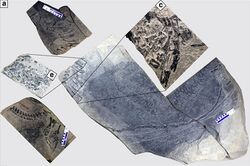Biology:Dinocephalosauridae
| Dinocephalosauridae | |
|---|---|

| |
| Referred specimen of Dinocephalosaurus orientalis, the type species | |
| Scientific classification | |
| Domain: | Eukaryota |
| Kingdom: | Animalia |
| Phylum: | Chordata |
| Class: | Reptilia |
| Clade: | Archosauromorpha |
| Clade: | †Dinocephalosauridae Spiekman et al. 2021 |
| Genera | |
Dinocephalosauridae is an extinct clade of marine and terrestrial archosauromorph reptiles that lived throughout the Triassic period. Like tanystropheids, they are characterized by their long necks, lengthened by either addition of cervical vertebrae or elongation of the individual bones.[1]
Dinocephalosaurids are known from Europe (Poland , Germany , Austria, Netherlands)[2] and China.[3] [4] Some members (i.e. Dinocephalosaurus) are solely marine animals, most likely living near the coastlines of the Tethys Ocean, while other members (i.e. Pectodens) were purely terrestrial, suggesting wide ecological diversity in just the few known species in this family.
Classification
In 2021, a phylogenetic study was conducted by S. Spiekman, N. Fraser, and T. Schayer in an attempt to clarify the systematics of "protorosaur" groups. A total of 16 individual trees were found using different character scoring methods and unstable OTU exclusions. The results of analysis 3A, with ratio and ordered characters treated as such and pruning 5 out of 40 OTUs a posteriori to offer maximum resolution/minimum polytomies, are shown:[5]
The clade Dinocephalosauridae is a node-based clade defined as "Dinocephalosaurus orientalis, Pectodens zhenyuensis, their most recent common ancestor, and all its descendants."[5]
| Diapsida |
| ||||||||||||||||||||||||||||||||||||||||||||||||||||||||||||||||||||||||||||||||||||||||||||||||||||||||||||||||||||||||||||||||||||||||||||||||||||||||||||||||
In their 2023 description of the dinocephalosaurid Austronaga, Wang, Lei & Li recovered it as a member of the Dinocephalosauridae, as the sister taxon to Dinocephalosaurus. The results of their phylogenetic analyses are shown in the cladogram below:[6]
| Archosauromorpha |
| ||||||||||||||||||||||||||||||||||||||||||||||||||||||||||||||||||||||||||||||||||||||||||||||||||||||||||||
References
- ↑ Rieppel, O. (2001). "A new species of Tanystropheus (Reptilia: Protorosauria) from the Middle Triassic of Makhtesh Ramon, Israel". Neues Jahrbuch für Geologie und Paläontologie - Abhandlungen 221 (2): 271–287. doi:10.1127/njgpa/221/2001/271. https://www.schweizerbart.de/papers/njgpa/detail/221/82704/A_new_species_of_Tanystropheus_Reptilia_Protorosauria_from_the_Middle_Triassic_of_Makhtesh_Ramon_Israel?l=EN.
- ↑ Sennikov, A. G. (2011). "New tanystropheids (Reptilia: Archosauromorpha) from the Triassic of Europe". Paleontological Journal 45 (1): 90–104. doi:10.1134/S0031030111010151.
- ↑ Li, C.; Fraser, N.C.; Rieppel, O.; Zhao, L.-J.; Wang, L.-T. (2017). "A new diapsid from the Middle Triassic of southern China". Journal of Paleontology 91 (6): 1306–1312. doi:10.1017/jpa.2017.12. Bibcode: 2017JPal...91.1306L. https://www.cambridge.org/core/services/aop-cambridge-core/content/view/856F9F54B5A63FE0B98D249753865673/S0022336017000129a.pdf/new_diapsid_from_the_middle_triassic_of_southern_china.pdf.
- ↑ Li, C. (2003). "First record of protorosaurid reptile (Order Protorosauria) from the Middle Triassic of China". Acta Geologica Sinica - English Edition 77 (4): 419–423. doi:10.1111/j.1755-6724.2003.tb00122.x.
- ↑ 5.0 5.1 Spiekman, S. N. F.; Fraser, N. C.; Scheyer, T. M. (2021). "A new phylogenetic hypothesis of Tanystropheidae (Diapsida, Archosauromorpha) and other "protorosaurs", and its implications for the early evolution of stem archosaurs". PeerJ 9: e11143. doi:10.7717/peerj.11143. PMID 33986981.
- ↑ Wang, W.; Lei, H.; Li, C. (2023). "A small-sized dinocephalosaurid archosauromorph from the Middle Triassic of Yunnan, southwestern China". Vertebrata PalAsiatica. doi:10.19615/j.cnki.2096-9899.231013. http://www.vertpala.ac.cn/EN/10.19615/j.cnki.2096-9899.231013.
Wikidata ☰ Q108281358 entry
 |

